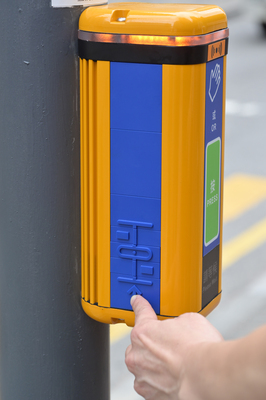Audible traffic signals to be upgraded

A tactile map is provided on the side of the new eATS units, just one of several user-friendly features that provide added convenience for visually impaired people.
The Transport Department today announced a citywide gradual renewal of electronic audible traffic signals (eATS) at signalised crossings, with new features being incorporated that provide convenience for the visually impaired and other people.
The original units indicate the status of pedestrian traffic to visually impaired people by emitting sound and vibration signals so that they know when to cross the road safely.
At some crossings with higher vehicle flows and lower pedestrian traffic, eATS units are equipped with a pedestrian push-button function. The green pedestrian signal will only be activated after it is pressed, allowing more vehicles to pass through the junction.
Besides retaining these existing functions, five new features have been added to the new-generation eATS units to better meet users’ needs.
An illumination unit is installed at the top of the new units, making it easier for those with amblyopia to locate the pedestrian crossing.
Secondly, a tactile map is provided on the side of the units, providing layout information about the crossing for the visually impaired.
A voice message about the crossing’s location is also added. By pressing the activation button at the bottom, the device will read out the name of streets near the crossing in Cantonese, Putonghua and English to inform users of their location.
Fourthly, a touchless pedestrian push button sensor is provided, allaying users’ hygiene concerns.
The fifth feature is a new night-time operation mode. When no visually impaired people are seeking to cross the road at night, the unit’s operating volume will be lower than the existing level to reduce its impact on neighbouring residents.
Visually impaired people can use the remote-control function on a newly designed dedicated wireless device, or the “HKeMobility” mobile app, to temporarily increase volume on an eATS unit when they need to cross the road.
About 15,000 dedicated wireless devices will be distributed free of charge to visually impaired people in the third quarter of this year to launch the new function.
The Transport Department said most of the existing eATS units have exceeded their normal lifespan after being in operation for over two decades, adding that their fault rate has been increasing, necessitating a large-scale replacement.
The department commenced replacement of some 13,000 eATS units at about 2,000 junctions across the city from April in phases, and the replacement is expected to be completed by end-2027.